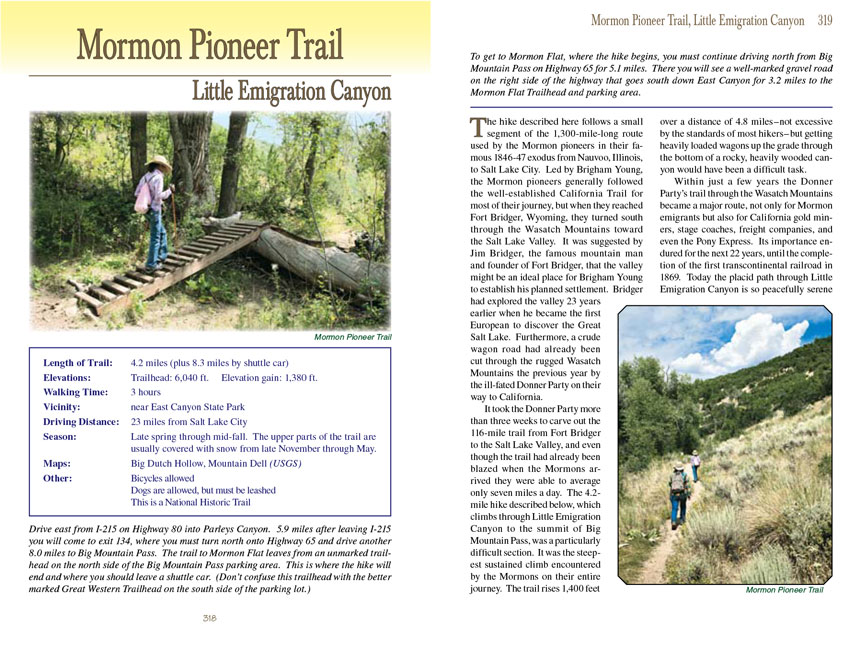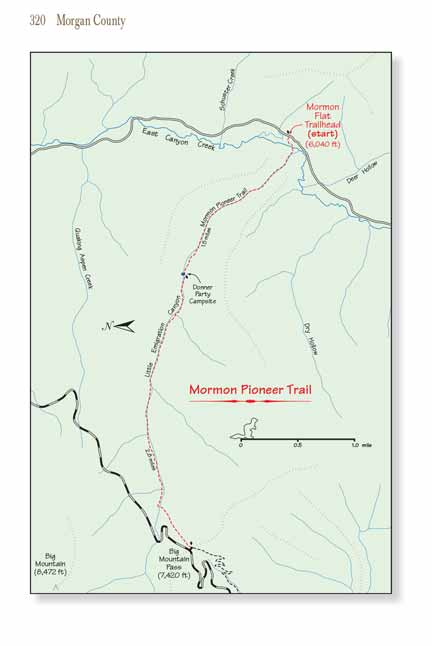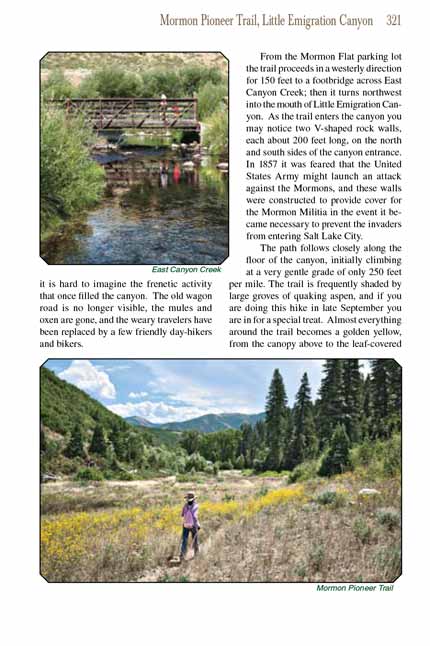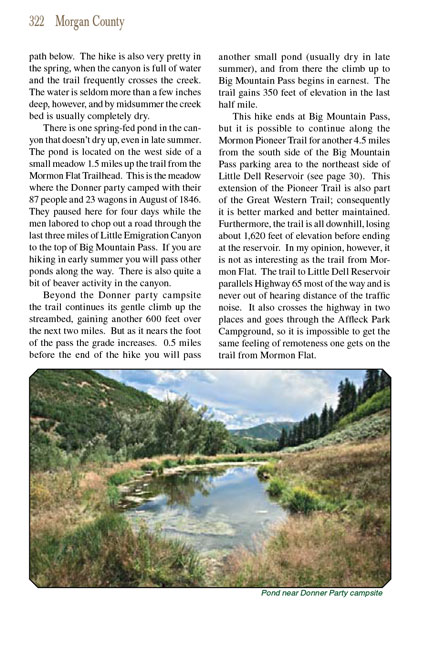Mormon Pioneer Trail
Little Emigration Canyon
excerpted from our book
Salt Lake City's Incredible Hiking and Biking Trails
pages 318-322
|
Buy book directly from the author!
Salt Lake City's Incredible Hiking and Biking Trails
- has access info for 73 trailheads
- 73 colorful trail maps
- 325 full color photographs
- loads of hiking tips
|
regularly $19.95
now on sale for only
$9.95
click here
for book orders
|


 The hike described here follows a small segment of the 1,300-mile-long route used by the Mormon pioneers in their famous 1846-47
exodus from Nauvoo, Illinois, to Salt Lake City. Led by Brigham Young, the Mormon pioneers generally followed the well-established California Trail for most
of their journey, but when they reached Fort Bridger, Wyoming, they turned south through the Wasatch Mountains toward the Salt Lake Valley. It was suggested
by Jim Bridger, the famous mountain man and founder of Fort Bridger, that the valley might be an ideal place for Brigham Young to establish his planned
settlement. Bridger had explored the valley 23 years earlier when he became the first European to discover the Great Salt Lake. Furthermore, a crude
wagon road had already been cut through the rugged Wasatch Mountains the previous year by the ill-fated Donner Party on their way to California.
The hike described here follows a small segment of the 1,300-mile-long route used by the Mormon pioneers in their famous 1846-47
exodus from Nauvoo, Illinois, to Salt Lake City. Led by Brigham Young, the Mormon pioneers generally followed the well-established California Trail for most
of their journey, but when they reached Fort Bridger, Wyoming, they turned south through the Wasatch Mountains toward the Salt Lake Valley. It was suggested
by Jim Bridger, the famous mountain man and founder of Fort Bridger, that the valley might be an ideal place for Brigham Young to establish his planned
settlement. Bridger had explored the valley 23 years earlier when he became the first European to discover the Great Salt Lake. Furthermore, a crude
wagon road had already been cut through the rugged Wasatch Mountains the previous year by the ill-fated Donner Party on their way to California.
It took the Donner Party more than three weeks to carve out the 116-mile trail from Fort Bridger to the Salt Lake Valley, and even though the trail had already
been blazed when the Mormons arrived they were able to average only seven miles a day. The 4.2-mile hike described below, which climbs through Little Emigration
Canyon to the summit of Big Mountain Pass, was a particularly difficult section. It was the steepest sustained climb encountered by the Mormons on their entire
journey. The trail rises 1,400 feet over a distance of 4.8 miles-not excessive by the standards of most hikers-but getting heavily loaded wagons up the grade
through the bottom of a rocky, heavily wooded canyon would have been a difficult task.
Within just a few years the Donner Party’s trail through the Wasatch Mountains became a major route, not only for Mormon emigrants but also for California
gold miners, stage coaches, freight companies, and even the Pony Express. Its importance endured for the next 22 years, until the completion of the first
transcontinental railroad in 1869. Today the placid path through Little Emigration Canyon is so peacefully serene it is hard to imagine the frenetic activity
that once filled the canyon. The old wagon road is no longer visible, the mules and oxen are gone, and the weary travelers have been replaced by a few
friendly day-hikers and bikers.
 From the Mormon Flat parking lot the Mormon
Pioneer Trail proceeds in a westerly direction for 150 feet to a footbridge across East Canyon Creek;
then it turns northwest into the mouth of Little Emigration Canyon. As the trail enters the canyon you may notice two V-shaped rock walls, each about 200 feet
long, on the north and south sides of the canyon entrance. In 1857 it was feared that the United States Army might launch an attack against the Mormons, and
these walls were constructed to provide cover for the Mormon Militia in the event it became necessary to prevent the invaders from entering Salt Lake City.
From the Mormon Flat parking lot the Mormon
Pioneer Trail proceeds in a westerly direction for 150 feet to a footbridge across East Canyon Creek;
then it turns northwest into the mouth of Little Emigration Canyon. As the trail enters the canyon you may notice two V-shaped rock walls, each about 200 feet
long, on the north and south sides of the canyon entrance. In 1857 it was feared that the United States Army might launch an attack against the Mormons, and
these walls were constructed to provide cover for the Mormon Militia in the event it became necessary to prevent the invaders from entering Salt Lake City.
The Mormon Pioneer Trail follows closely along the floor of the canyon, initially climbing at a very gentle grade of only 250 feet per mile. The trail is frequently shaded by
large groves of quaking aspen, and if you are doing this hike in late September you are in for a special treat. Almost everything around the trail becomes a
golden yellow, from the canopy above to the leaf-covered path below. The
Mormon Pioneer Trail is also very pretty in the spring, when the canyon is full of water and the trail
frequently crosses the creek. The water is seldom more than a few inches deep, however, and by midsummer the creek bed is usually completely dry.
There is one spring-fed pond in the canyon that doesn’t dry up, even in late summer. The pond is located on the west side of a small meadow 1.5 miles up the
trail from the Mormon Flat Trailhead. This is the meadow where the Donner party camped with their 87 people and 23 wagons in August of 1846. They paused here
for four days while the men labored to chop out a road through the last three miles of Little Emigration Canyon to the top of Big Mountain Pass. If you are
hiking the Mormon Pioneer Trail in early summer you will pass other ponds along the way. There is also quite a bit of beaver activity in the canyon.
Beyond the Donner party campsite the trail continues its gentle climb up the streambed, gaining another 600 feet over the next two miles. But as it nears the
foot of the pass the grade increases. 0.5 miles before the end of the hike you will pass another small pond (usually dry in late summer), and from there the
climb up to Big Mountain Pass begins in earnest. The trail gains 350 feet of elevation in the last half mile.
This hike along the Mormon Pioneer Trail ends at Big Mountain Pass, but it is possible to continue along the Mormon Pioneer Trail for another 4.5 miles from the south side of the Big Mountain
Pass parking area to the northeast side of Little Dell Reservoir (see page 30). This extension of the
Mormon Pioneer Trail is also part of the Great Western Trail;
consequently it is better marked and better maintained. Furthermore, the trail is all downhill, losing about 1,620 feet of elevation before ending at the
reservoir. In my opinion, however, it is not as interesting as the trail from Mormon Flat. The trail to Little Dell Reservoir parallels Highway 65 most
of the way and is never out of hearing distance of the traffic noise. It also crosses the highway in two places and goes through the Affleck Park Campground,
so it is impossible to get the same feeling of remoteness one gets on the trail from Mormon Flat.
Note to web developers: You may copy this material onto your site, but in return please include a link to my home page
www.utahtrails.com. Thank you, David Day (utahdavidday at gmail.com)
Click here to see more
trails near Salt Lake City
© Rincon Publishing Company, all rights reserved
|


 The hike described here follows a small segment of the 1,300-mile-long route used by the Mormon pioneers in their famous 1846-47
exodus from Nauvoo, Illinois, to Salt Lake City. Led by Brigham Young, the Mormon pioneers generally followed the well-established California Trail for most
of their journey, but when they reached Fort Bridger, Wyoming, they turned south through the Wasatch Mountains toward the Salt Lake Valley. It was suggested
by Jim Bridger, the famous mountain man and founder of Fort Bridger, that the valley might be an ideal place for Brigham Young to establish his planned
settlement. Bridger had explored the valley 23 years earlier when he became the first European to discover the Great Salt Lake. Furthermore, a crude
wagon road had already been cut through the rugged Wasatch Mountains the previous year by the ill-fated Donner Party on their way to California.
The hike described here follows a small segment of the 1,300-mile-long route used by the Mormon pioneers in their famous 1846-47
exodus from Nauvoo, Illinois, to Salt Lake City. Led by Brigham Young, the Mormon pioneers generally followed the well-established California Trail for most
of their journey, but when they reached Fort Bridger, Wyoming, they turned south through the Wasatch Mountains toward the Salt Lake Valley. It was suggested
by Jim Bridger, the famous mountain man and founder of Fort Bridger, that the valley might be an ideal place for Brigham Young to establish his planned
settlement. Bridger had explored the valley 23 years earlier when he became the first European to discover the Great Salt Lake. Furthermore, a crude
wagon road had already been cut through the rugged Wasatch Mountains the previous year by the ill-fated Donner Party on their way to California.
 From the Mormon Flat parking lot the Mormon
Pioneer Trail proceeds in a westerly direction for 150 feet to a footbridge across East Canyon Creek;
then it turns northwest into the mouth of Little Emigration Canyon. As the trail enters the canyon you may notice two V-shaped rock walls, each about 200 feet
long, on the north and south sides of the canyon entrance. In 1857 it was feared that the United States Army might launch an attack against the Mormons, and
these walls were constructed to provide cover for the Mormon Militia in the event it became necessary to prevent the invaders from entering Salt Lake City.
From the Mormon Flat parking lot the Mormon
Pioneer Trail proceeds in a westerly direction for 150 feet to a footbridge across East Canyon Creek;
then it turns northwest into the mouth of Little Emigration Canyon. As the trail enters the canyon you may notice two V-shaped rock walls, each about 200 feet
long, on the north and south sides of the canyon entrance. In 1857 it was feared that the United States Army might launch an attack against the Mormons, and
these walls were constructed to provide cover for the Mormon Militia in the event it became necessary to prevent the invaders from entering Salt Lake City.